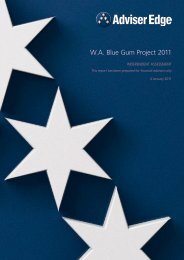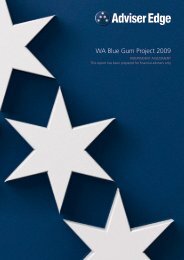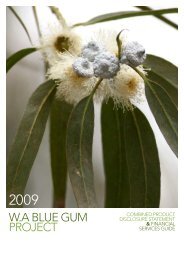download WA Blue Gum Project Product Disclosure Statement 2013
download WA Blue Gum Project Product Disclosure Statement 2013
download WA Blue Gum Project Product Disclosure Statement 2013
Create successful ePaper yourself
Turn your PDF publications into a flip-book with our unique Google optimized e-Paper software.
Leasing arrangements with landholders are developedfollowing extensive on site discussion with the owner andrelevant land use authorities and fire protection agencies.The concept is to draw up a final plan, which thelandowner, authorities, <strong>WA</strong>CAP Treefarms and the <strong>Project</strong>Manager all agree upon.RisksIn past years where rainfall was low some drought deathsof Eucalyptus globulus occurred in plantations in theSouth West. This was a reflection of below average rainfalland the limits of knowledge on soil types and other factorswhen the first broad scale plantings were made. Sincethen responsible operators such as <strong>WA</strong>CAP Treefarmscarry out a soil drilling or backhoe digging survey to aminimum of three metres depth over the property toexclude unfavourable sections. The drilling depth may beextended to five metres or more where there is uncertaintyabout the nature of the deeper material. This practicecombined with only selecting properties for this <strong>Project</strong>likely to receive greater than 900 mm of rainfall per yeargreatly minimises the risk of tree death in a low rainfallyear. An observed 10% decrease in rainfall in the SouthWest since the 1970's due to natural variation and or othercauses may reduce future growth rates. Any reduction ismore likely to be experienced in lower rainfall areas whereblue gum plantations are already marginal than in thehigher rainfall zones where <strong>WA</strong> <strong>Blue</strong> <strong>Gum</strong> Limitedplantations will be established.Rising saline groundwater has been a widespreadproblem in farmland in parts of the South West. Soilsalinities greater than EC 50 mS/m have been shown toaffect growth rates and survival of Eucalyptus globulus.<strong>WA</strong>CAP Treefarms routinely carry out salinity sampling ofland to be planted and exclude those areas where salinitycould be a problem in the future. This is very soundpractice and minimises the risk of future salinity effects ona plantation.On first rotation sites the fire risk to blue gum plantations isvery low up until about age 8 when leaf litter begins tobuild up. On second rotation sites the residual debris afterclear-felling means that these plantations are exposed to ahigher fire risk than did the first rotation. All plantationcompanies are aware of this and take steps to reduce therisk by disposing of clear-felling debris for a zone aroundthe perimeter before establishing the new crop. To datethe loss of plantations in <strong>WA</strong> due to fire has been very low.The proposed biomass plant to be built near Diamond anddesigned to burn plantation debris to produce energywould have had the capacity to reduce fuel levels afterharvesting. When the biomass plant will be built isuncertain due to the downturn in the economy.Management OperationsLocal contractors under <strong>WA</strong>CAP Treefarms supervisioncarry out planting and tending. After rain, a combination ofknockdown and residual herbicide is applied to the moundor ripped planting line prior to planting. Fertiliser type, rateand application methods are selected following pre-plantsoil sampling and site assessment. Having seen most ofthe Eucalyptus globulus plantation establishment in theSouth West and the Green Triangle in South Australia overmany years, I rate current practice and results by <strong>WA</strong>CAPTreefarms as being of an extremely high standard.Seedlings are raised in the <strong>WA</strong>CAP Treefarms nursery atManjimup. This nursery, constructed in 1993, has acapacity to produce up to seven million seedlings eachyear and uses some of the best nursery technologyavailable and consistently produces good qualityseedlings. Up to three years sowing requirements areheld in secure storage, which ensures security of seedsupply. Trees are planted in rows either 4 or 5 metresapart, aiming for a stocking rate of 800 - 1,000 seedlingsper hectare, depending on soil conditions and rainfall.With the detailed attention given to pre plantingestablishment, seedling survival is often close to 100%.Further herbicide spraying is carried out in late spring ifrequired and additional fertiliser application takes placeduring the rotation if growth rate monitoring indicates abenefit will be obtained.<strong>WA</strong>CAP Treefarms have been a long term member of theSouthern Tree Breeders Association and involved in acooperative breeding program to further improve thegenetic strain of Eucalyptus globulus. Seed orchards tosupply elite seed in the future have been establishedusing seed from identified superior parent trees as well asclones and grafts of superior individuals.Processing and LogisticsHarvesting by a mechanical harvester is an efficient andlow cost operation at about 10 years of age. Piece size,which has an important bearing on harvesting costs, hasbeen very satisfactory in harvesting carried out so far.Limiting initial stocking to 800 -1000 trees per hectare onmost sites promotes the development of larger diametertrees at the time of clearfelling. Mechanical harvestersutilise down to a small diameter limit thus ensuring greateryield of chiplog and minimal waste.<strong>WA</strong> Chip and Pulp another wholly owned subsidiary of<strong>WA</strong>PRES purchase and process the timber. The majorchipping facilities are at the <strong>WA</strong> Chip and Pulp mill atBunbury Port. A loading facility is available at BunburyPort. A chip mill north of Albany and loading facilities atAlbany Port have been operating for over ten years withwoodchips being exported from Albany Port.Market Outlook and <strong>Product</strong> PotentialThe fibre obtained from Eucalyptus globulus has nowbecome the principal source of woodchip exports. Karri(Eucalyptus diversicolor) woodchips previously obtainedfrom State managed native forests in the South West havefallen to about 200,000 tonnes per year as a consequenceof State government forest policies on harvesting in nativeforests. Samples taken from Eucalyptus globulus grown inWestern Australia by <strong>WA</strong>CAP Treefarms have been shownby CSIRO to provide significantly better quality and higherpulp yields than from native forest timbers from Tasmania.Consequently, woodchips from Eucalyptus globulusshould always command a higher price in the exportmarket. The Wood Purchase Agreement provides asecure market arrangement for growers.






